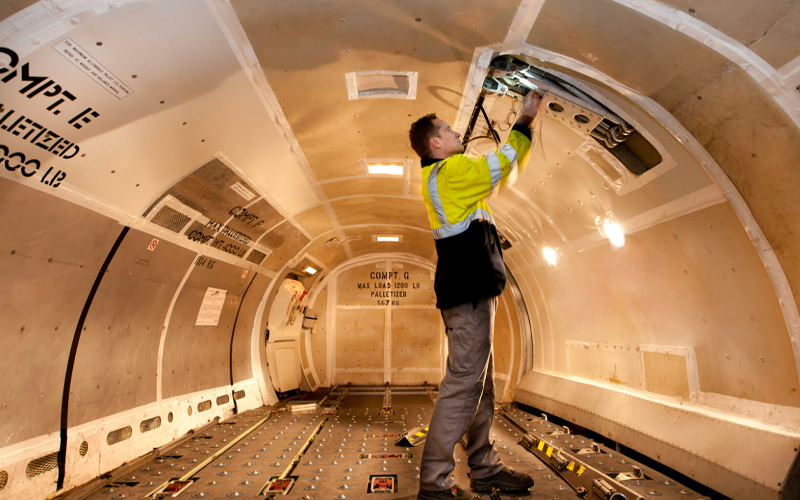Aircraft maintenance is the backbone of aviation safety. Any oversight, however small, can have significant consequences. From technical malfunctions and compliance failures to cybersecurity breaches and human error, the risks are many. Effective risk mitigation in aviation maintenance is not optional – it is essential for ensuring safety, efficiency, and operational continuity. With increasing regulatory complexity, ageing fleets, and emerging technologies, there is a growing urgency for advanced aviation maintenance risk management strategies.
Key aviation maintenance risk management best practices
Managing risk in aviation maintenance requires a mix of innovation, technology, and process improvements. The evolving risks underscore the need for best practices that can not only mitigate issues but also future-proof aviation operations.
Implement advanced monitoring and predictive analytics
Deploying real-time monitoring tools and predictive analytics helps identify early signs of component failure, reducing unplanned downtime. These systems enhance visibility into aircraft health and support proactive decision-making, which is essential for effective risk mitigation in aviation maintenance.
Use 3D printing and additive manufacturing for efficient part replacement
3D printing accelerates the production of complex, low-volume parts, reducing lead times and inventory costs. Additive manufacturing enables on-demand part replacement, streamlining repairs and supporting sustainable operations, which enhances aviation maintenance and risk management.
Enhance workforce capabilities with continuous training and immersive technologies
Investing in skill development through AR, VR, and simulation tools bridges knowledge gaps and improves on-the-job performance. These technologies create realistic scenarios for hands-on learning, which is vital for maintaining safety and resilience in aviation maintenance and risk management.
Ensure regulatory compliance with automated tools and digital documentation
Automated compliance tools simplify adherence to evolving aviation regulations. Digital documentation and audit trails improve transparency and minimise errors, allowing maintenance teams to focus on safety-critical tasks while staying compliant with industry standards.
Optimise supply chain and inventory with blockchain and digital systems
Using blockchain for inventory and part tracking ensures data integrity and reduces procurement delays. Digital systems enhance visibility across the supply chain, lowering the risk of counterfeits and improving operational efficiency within aviation MRO ecosystems.
Automate processes and integrate robotics to address labour shortages
Robotic systems and automation streamline routine tasks, enabling precision and reducing dependency on manual labour. This approach helps overcome workforce shortages and the potential for human errors while maintaining consistent quality in aircraft inspections and repairs.
Enable remote diagnostics and connected maintenance through IoT
IoT-enabled sensors and systems support remote diagnostics, allowing real-time issue identification and resolution without physical presence. This connected approach improves response times and supports aviation maintenance safety and risk management by reducing delays in critical maintenance.
Strengthen cybersecurity with robust protocols and regular audits
Implementing secure networks, encryption, and access controls protects sensitive aircraft data from cyber threats. Regular security audits and incident response plans are essential to safeguard maintenance operations from digital vulnerabilities.
Manage fatigue risks with smart scheduling and ergonomic tools
Ergonomically designed work environments and data-driven shift scheduling reduce fatigue and human error. Fatigue risk management is critical in aviation, directly influencing technician performance and overall safety.
Together, best practices form the foundation of a proactive and future-ready aviation maintenance risk management strategy. By embedding these approaches into day-to-day operations, aviation businesses can better manage risk, improve safety, and drive long-term operational resilience.
Role of technology in aviation safety and maintenance risk management
Modern technologies continue to reshape how the aviation industry tackles maintenance risk. These tools not only make aviation maintenance safer but also more efficient and cost-effective.
- Predictive maintenance: Forecasts issues before they become critical
- 3D printing and additive manufacturing: Enables faster and cost-effective part replacements
- AR and VR integration: Transforms training and maintenance workflows
- Unmanned Aerial Vehicles (UAVs): Streamline inspections in hard-to-reach areas
- Blockchain: Enhances supply chain transparency and traceability
- AI and ML: Power predictive analytics and decision-making
- Smart wearables for technicians: Monitor fatigue and provide real-time assistance
- IoT: Connects systems for seamless monitoring and control
- Robotics: Automates repetitive tasks and improves precision
Infosys BPM offers end-to-end aviation MRO solutions that support businesses in reducing risk, improving compliance, and enhancing operational efficiency. With deep domain expertise and cutting-edge digital capabilities, Infosys BPM allows airlines to leverage next-gen technologies to revolutionise their MRO operations and enable seamless aviation maintenance risk management tailored to industry needs.
Risk is an inevitable reality in aviation, but with proactive strategies and best practices, airlines can manage them effectively. With a combination of innovation, technology, and process improvements, the industry can not only strengthen compliance and address workforce challenges but also elevate aviation maintenance and safety risk management to ensure long-term resilience.








